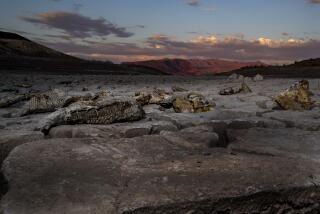A gloomy forecast for crops and forests
- Share via
DENVER — Climate change is increasing the risk of U.S. crop failures, depleting the nation’s water resources and contributing to outbreaks of invasive species and insects, the Department of Agriculture said in a report released Tuesday.
Those and other problems for the U.S. livestock and forestry industries will persist for at least the next 25 to 50 years, said the report compiled by 38 scientists for use by water and land managers.
“I think what’s really eye-opening is the depth and breadth of the impacts and consequences going on right now,” said Anthony C. Janetos, a study author and director of the Joint Global Change Research Institute at the University of Maryland.
Less than a year ago, the Bush administration submitted a report to the United Nations that did not mention how global warming could affect wildfires, heat waves, agriculture or snowpack.
Scientists reviewed and synthesized research from more than 1,000 publications to produce the report, which is part of a federal assessment of global warming for the U.S. Climate Change Science Program, sponsored by 13 federal agencies.
“Just to see it all there like that and to realize the impacts are pervasive right now is a little bit scary,” said Peter Backlund, director of research relations at the National Center for Atmospheric Research in Boulder, Colo.
Drought-strained forests in the West and Southeast are easy prey for tree-killing insects such as bark beetles. Snow in the Western mountains melts earlier, making it more difficult for managers overseeing a long-established system of reservoirs and irrigation ditches that serves Western states.
The Southeast doesn’t have the same kind of storage system because rain historically has been more consistent there. Current weather disruptions, however, have the region struggling with drought, Janetos said.
Rising carbon dioxide levels are changing the metabolism of grasses and shrubs on rangeland, decreasing the protein levels in plants eaten by cattle. Joshua trees and saguaro cacti could dwindle or face extinction.
Warmer, drier weather is altering the biodiversity of Southwest deserts and the high, colder deserts of Nevada, Utah and Washington, said Steven Archer of the University of Arizona. Plants and animals living in extreme conditions face threats from wildfires and nonnative species, he said.
“These areas historically support a large ranching industry, wildlife habitat,” Archer said. “They are major watersheds and airsheds.”
The researchers said that of 1,598 animal species examined in more than 800 studies, nearly 60% had been affected by climate change.
The scientists said longer growing seasons provided by higher temperatures did not necessarily translate into bigger crop yields because plants had certain growth patterns.
Their report focuses on the next 25 to 50 years, rather than the next 100 years as other studies have done.
“Sometimes it’s so far out that people just don’t grasp that it’s a problem,” said Jerry Hatfield, lab director of the National Soil Tilth Research Laboratory in Ames, Iowa. “This really brings it home.”
--
The Washington Post contributed to this report.






